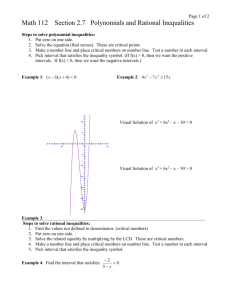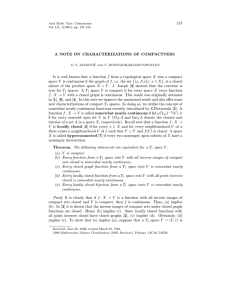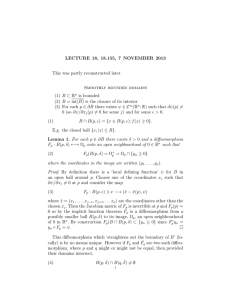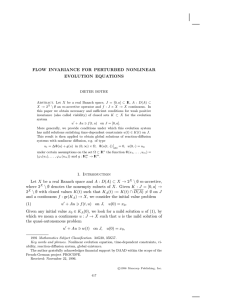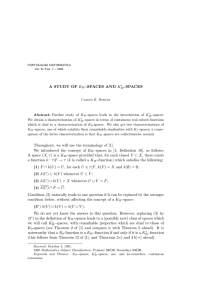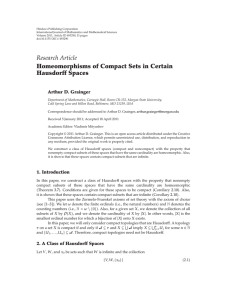Example Problems for Distributions
advertisement
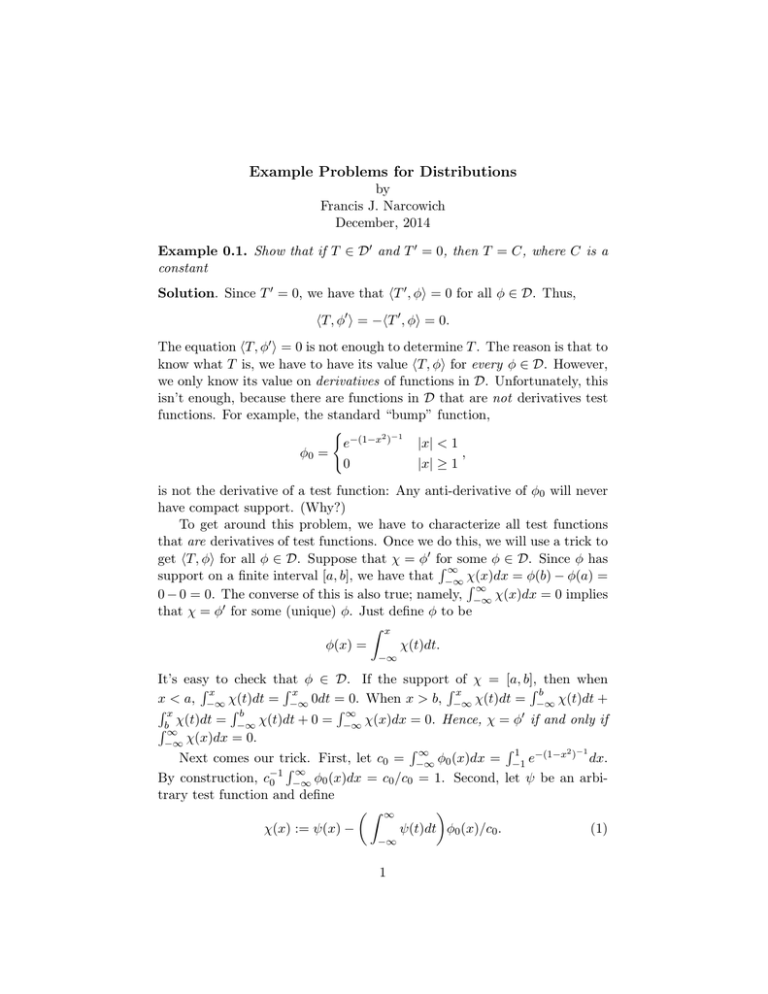
Example Problems for Distributions
by
Francis J. Narcowich
December, 2014
Example 0.1. Show that if T ∈ D0 and T 0 = 0, then T = C, where C is a
constant
Solution. Since T 0 = 0, we have that hT 0 , φi = 0 for all φ ∈ D. Thus,
hT, φ0 i = −hT 0 , φi = 0.
The equation hT, φ0 i = 0 is not enough to determine T . The reason is that to
know what T is, we have to have its value hT, φi for every φ ∈ D. However,
we only know its value on derivatives of functions in D. Unfortunately, this
isn’t enough, because there are functions in D that are not derivatives test
functions. For example, the standard “bump” function,
(
2 −1
e−(1−x )
|x| < 1
φ0 =
,
0
|x| ≥ 1
is not the derivative of a test function: Any anti-derivative of φ0 will never
have compact support. (Why?)
To get around this problem, we have to characterize all test functions
that are derivatives of test functions. Once we do this, we will use a trick to
get hT, φi for all φ ∈ D. Suppose that χ = φ0 for
R ∞some φ ∈ D. Since φ has
support on a finite interval [a, b], we have that −∞ χ(x)dx = φ(b) − φ(a) =
R∞
0 − 0 = 0. The converse of this is also true; namely, −∞ χ(x)dx = 0 implies
that χ = φ0 for some (unique) φ. Just define φ to be
Z x
φ(x) =
χ(t)dt.
−∞
It’s easy to check that φ ∈ D. If the support of χ = [a, b], then when
Rx
Rx
Rx
Rb
x < a, −∞ χ(t)dt = −∞ 0dt = 0. When x > b, −∞ χ(t)dt = −∞ χ(t)dt +
Rx
Rb
R∞
χ(t)dt = −∞ χ(t)dt + 0 = −∞ χ(x)dx = 0. Hence, χ = φ0 if and only if
Rb∞
−∞ χ(x)dx = 0.
R∞
R1
2 −1
Next comes our trick. First, let c0 = −∞ φ0 (x)dx = −1 e−(1−x ) dx.
R
∞
By construction, c−1
0
−∞ φ0 (x)dx = c0 /c0 = 1. Second, let ψ be an arbitrary test function and define
Z ∞
χ(x) := ψ(x) −
ψ(t)dt φ0 (x)/c0 .
(1)
−∞
1
We have that χ ∈ D because it is a linear combination of test functions.
Third, note that
Z ∞
Z ∞
Z ∞
Z ∞
ψ(x)dx −
ψ(x)dx
(φ0 (t)/c0 )dt
χ(x)dx =
−∞
−∞
−∞
−∞
Z ∞
Z ∞
=
ψ(x)dx −
ψ(x)dx · 1 = 0.
−∞
−∞
By what we just said, χ = φ0 , for some φ. Therefore,
Z ∞
ψ(t)dt
φ0 = ψ − h1, ψiφ0 /c0 , where h1, ψi =
−∞
and so ψ = φ0 + h1, ψiφ0 /c0 . Finally, apply T to both sides to get
hT, ψi = hT, φ0 i + hT, φ0 /c0 ih1, ψi = hC, ψi.
| {z } | {z }
0
C
Since φ0 /c0 is a specific function, C = hT, φ0 i/c0 is a constant that is independent of ψ. The equation above then implies that T = C.
Example 0.2. Find all u ∈ D0 that solve x2 u0 = 0, in the sense of distributions.
Solution. The equation x2 u0 = 0 implies that 0 = hx2 u0 , φi = hu, (x2 φ)0 i.
2
0
We begin by finding all χ ∈ D such that χ(x)
R x = (x φ(x)) for some φ ∈ D.
2
Integrating this equation yields x φ(x) = 0 χ(t)dt. Since φ has compact
Rb
R∞
support in an interval [a, b], x > b implies that 0 χ(t)dt = 0 χ(t)dt =
R0
R0
b2 φ(b) = 0. Similarly, −∞ χ(t)dt = a χ(t)dt = −a2 φ(a) = 0. DifferentiR
x
ating x2 φ(x) = 0 ψ(t)dt yields 2xφ(x) + x2 φ0 (x) = χ(x). Setting x = 0
then results in χ(0) = 0. Putting these together, we see that χ satisfies the
following (necessary) conditions:
Z 0
Z ∞
χ(x)dx =
χ(x)dx = 0, and ψ(0) = 0.
(2)
−∞
0
These are also sufficient. To see this, we must show that if χ ∈ D satisfies
(2), then
(
Rx
x−2 0 χ(t)dt, x 6= 0
φ(x) :=
(3)
χ0 (0),
x = 0.
is in D. Because χ ∈ D, Rit has support inRa finite interval [a, b]. Thus we, for
x
∞
x > b, have φ(x) = x−2 0 χ(t)dt = x−2 0 χ(t)dt = x−2 · 0 = 0. The same
2
argument also gives φ(x) = 0 for x < a. Thus, φ has compact support. All
that is left to get that φ is in D is showing that φ ∈ C ∞ . The only place
where φ is not clearly C ∞ is at x = 0. In a neighborhood of x = 0, we use
Taylor’s Theorem plus remainder to represent χ:
1
χ(n+1) (0) n+1
χ(x) = χ(0) +χ0 (0)x + χ00 (0)x2 · · · +
x
+ Rn+1 (x),
|{z}
2
(n + 1)!
(4)
0
R x (n+2)
where Rn+1 (x) = 0 χ(n+2)!(t) (x − t)n+2 dt = O{xn+2 }. Integrating (4) and
multiplying by x−2 , we see that
φ(x) := x−2
Z
x
0
1
1
χ(n+1) (0) n
χ(t)dt = χ0 (0) + χ00 (0)x · · · +
x + O{xn+1 },
2
6
(n + 2)!
from which it follows that at x = 0 the nth derivative of φ is φ(n) (0) =
ψ (n+1) (0)
(n+2)! .
Since n is arbitrary, φ is infinitely differentiable at 0. Consequently, φ is C ∞ everywhere, and, because it has compact support, φ ∈ D.
The trick that we used above in (1) can also be used here. Let φ0
be the bump function defined previously. Define φ1 (x) := φ0 (x − 1) and
φ2 (x) := φ0 (x + 1). These functions have supports
0], respecR ∞ [0, 2] and R[−2,
∞
tively. Thus, φ1 (0) = φ2 (0) = 0. In addition, 0 φ1 (x)dx = −∞ φ1 (x)dx =
R∞
R∞
φ2 (x)dx = c0 . Of course, because of the
−∞ φ0 (x)dx = c0 . Similarly, −∞
R∞
R0
supposrts of φ1 , φ2 , we also have −∞ φ1 (x)dx = 0 φ2 (x)dx = 0. Next, let
R∞
R0
ψ(t)dt
ψ(t)dt
0
ψ ∈ D and define χ(x) = ψ(x)− 2ψ(0)
φ1 (x)− −∞c0
φ2 (x). It
c0 φ 0 −
c0
is easy to check that χ satisfies the conditions in (2). Thus, there exists φ ∈
D such that (x2 φ(x))0 = χ(x), and so hx2 u0 , φi = hu, (x2 φ(x))0 i = hu, χi = 0.
Hence,
Z ∞
Z 0
2
1
1
hu, ψi − hu, φ0 i ψ(0) − hu, φ1 i
ψ(t) − hu, φ2 i
ψ(t)dt = 0.
c
c
c
| {z0 }
| {z0 } 0
| {z0 } −∞
a0
a1
a2
This result yields u = a0 δ(x) + a1 H(x) + a2 H(−x), where H(x) is the
Heaviside step function.
Previous: spectral theory
3






